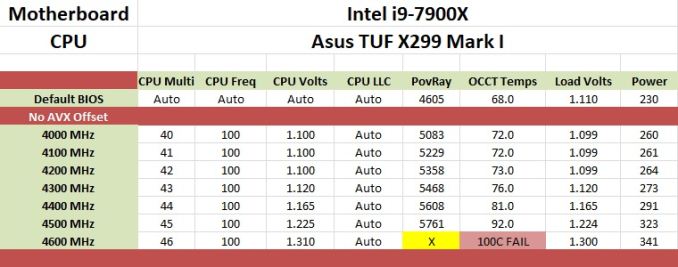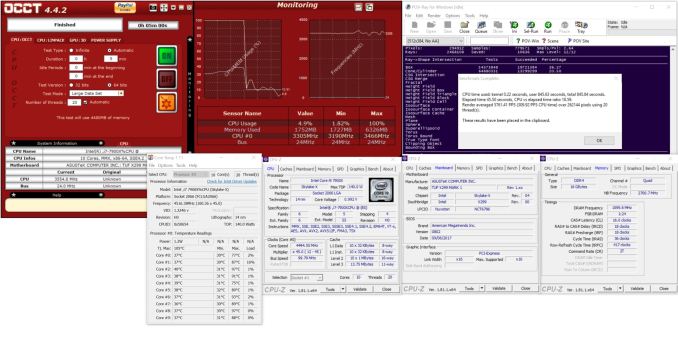The ASUS TUF X299 Mark I Motherboard Review: TUF Refined
by Joe Shields on December 6, 2017 9:30 AM EST- Posted in
- Motherboards
- Asus
- TUF
- X299
- Skylake-X
- Kaby Lake-X
Overclocking
Experience with the ASUS TUF X299 Mark 1
Automatic overclocking with the ASUS TUF was as simple as selecting which preset I want on the EZ System Tuning from within the BIOS or through the AI Suite/TUF software. The first setting attempted was named Extreme Tuning. When setting this option, the board gives a warning about the cooling required. This yielded a 39% overclock (there is a splash screen during POST showing this info) which came out to 4.6 GHz on all cores and ~1.30V. We know from our past manual testing of this chip, those voltages are a bit high for this CPU and will not pass our tests as the setup overwhelms our AIO cooler. The next step below that is Fast Tuning. When applying this option, the board sets the CPU to all cores running 4.3 GHz and voltage sits at 1.25V on load. We were able to pass our stability tests without issue here. Just be careful with the Extreme Tuning setting and that the right cooling is there for the job as its settings can overwhelm a lot of coolers on the market.
Manual overclocking was also easy through the ASUS BIOS. Unlike ASRock's BIOS, ASUS' overclocking options are all under one section, AI Tweaker. Users are able to change the vast majority, if not all options, for ambient overclocking of the CPU. Options like the CPU multiplier, BCLK, and Voltages for multiple domains are all found in the same section. The TUF did not have any issues with either set of memory and using the XMP profile so we were set there. The TUF also did not have an issue with setting the memory to 3600 MHz and running tests either (not pictured).
About the only thing to note here with this board are some of the sensor readings. CPUz doesn't seem to read vCore. When setting automatically or manually, the value remains close to what is seen in the picture below around .9V or so. OCCT was also unable to read the proper voltage. I am not entirely sure why this is happening, however, my theory is CPUz/OCCT are not hitting the proper registers for that value as the TUF has a few unique ICs for its Temperature monitoring/Thermal Radar. The good news is, the ASUS Thermal Radar 3 software picked it up accurately as well as my go-to temperature monitoring software, Coretemp.
I am pleasantly surprised to say that shroud covering the VRM heatsink didn't seem to cause any issues and did not see witness throttling in our testing.
Overclocking Methodology
Our standard overclocking methodology is as follows. We select the automatic overclock options and test for stability with POV-Ray and OCCT to simulate high-end workloads. These stability tests aim to catch any immediate causes for memory or CPU errors.
For manual overclocks, based on the information gathered from the previous testing, starts off at a nominal voltage and CPU multiplier, and the multiplier is increased until the stability tests are failed. The CPU voltage is increased gradually until the stability tests are passed, and the process repeated until the motherboard reduces the multiplier automatically (due to safety protocol) or the CPU temperature reaches a stupidly high level (90ºC+). Our test bed is not in a case, which should push overclocks higher with fresher (cooler) air.
Overclocking Results
Just as we saw on all the boards tested so far, we topped out at 4.5 GHz before we were temperature/cooling limited. In the 4.3 to 4.5 GHz clock speed range, the TUF did manage to use the least amount of voltage to pass our tests by a small margin of .005V. Truth be told, we read our voltages from software where read points are not found, so there is built in 'play' in the values listed. The voltage reduction didn't help push us past 4.5 GHz nor did it help with temperatures enough to worry about it. The ASUS BIOS does not show which level of LLC is active and was left on auto for testing. This yielded a WYSIWYG voltage from what was set in the BIOS to load. At 4.5 GHz and 1.225V, the system pulled 323W from the wall which was surprisingly the highest value of the boards tested so far.












15 Comments
View All Comments
Sn3akr - Thursday, December 7, 2017 - link
Are there ever gonna be a motherboard with clean lines and less appeal to 13-year old kids? 99.99% of the manufacturers all do black/red/gray colour, jagged edges and a missmash of edgy design feeatures. Guess i'll have to invest in a lazercutter to get clean lines and smooth design before i grow old and die. CLosest thing i've ever seen was ASUS Z97 SaberTooth Mark S, but then they went back to the teen tech.You can get some really nice cases, but if you try to match the hardware in one color other than black/red or black grey, then your in for a modding session. Currently making a white/purple build, but for some bizarre reason asus thinks all their "white boards" just needs a few blue details, and for the higher end cards.. then black/red or black/grey seems to be almost the only option, and has been for almost 10 years
sonny73n - Thursday, December 7, 2017 - link
It's just Asus with their dumb marketing gimmicks again. IMO their boards are the best but they're the worst values for the money. I'd go with ASRock instead.xray9 - Sunday, December 10, 2017 - link
Look to Supermicro server and workstation boards.I invested 3y ago into an X10SRi-F with E5-1650v3 or v4 .. works like a charm.
And even today it scales very nicely
- it has many PCIe 3.0 sockets with reasonable amount of PCIe lanes and some PCIe2.0
- if you compare the ratio of passmark performance divided by price, then you will see, that it the ratio is about the same compared to threadripper and Intel CPUs .. Which means you do not pay €1000 for threadripper which is quite expensive, you pay around €600 but get the same performance / price ratio
- you have with socket 2011-3 quad memory speed and ECC if you compare with Intel ...
- IPMI ...
Completely true enterprise segment products to a reasonable price.
So even 3y later absolutely compareable and expandable by PCI sockets with USB 3.1, further USB 3.0 or 10 Gigabit adapters if you require, PCIe based NVME ... all is possible.
super gaming - Thursday, December 14, 2017 - link
mother board asus tuf x2 does have amazing performance
<a href="http://gadgeton3.blogspot.com/2017/11/spesifikasi-...
lenovo super gaming laptop with cheap price</a>
tompreston301 - Monday, January 1, 2018 - link
thanks so much for the articles. I really like it. This is really awesome for those who want something awesome and good as you know.https://www.imobetachat.com/snapchat-for-pc-window...